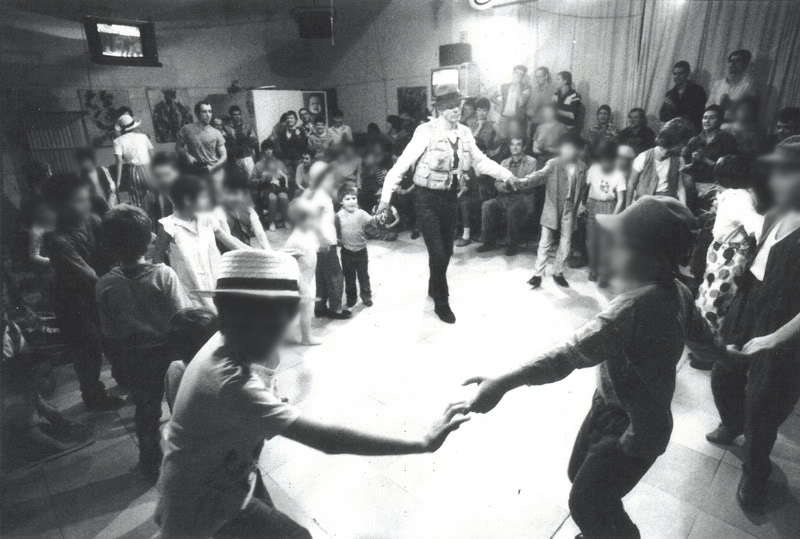Julia Sinelnikova, a.k.a., THE ORACLE, is a multimedia artist currently based in Brooklyn, NY.
With the tragic spectacle surrounding alternative spaces setting the backdrop, a light art and experimental music showcase I had spent the entirety of fall planning at a friend’s loft space in Bushwick was selected for a review in The New York Times. On the launch night of CHASM, high-powered projectors were aimed in every direction, live control centers set, dancers and a DJ warming up in the iridescent light environment. The event was meant to run for four nights with a rotating lineup of artists and performers. Unfortunately for my small production crew, it would be the worst week in recent history to attempt an independent event in Brooklyn. Just days after the fire at the unlicensed Ghost Ship warehouse, DIY spaces across the country had already been shuttered in a nationwide crackdown. Late on Friday afternoon, halfway through, we decided to close for the weekend to keep our audience safe from an aggressive shutdown.
Videos by VICE
“After Oakland Fire, Brooklyn Artists Vow to Keep Partying,” the resulting article reads online. To be sure, getting the event published, and having some of our artists highlighted, was an honor. But its framing alarmed many.

JHVH live performance with dancers Miu Soda and Cecile Klaus
As our community mourns friends in our extended network, we are seen as “partying.” Independent artists in major cities like New York and San Francisco are required to perform and stage openings independently on a weekly basis to maintain their income—but they’re “parties.” Authorities tend to crack down on DIY spaces at the last minute (the night of)—whether or not permits have been obtained—giving little to no time for event organizers to respond. Mainstream commercial galleries and licensed dance clubs, places where guests don’t regularly include minority artists, are meanwhile left to operate without fear of shutdown in the form of a raid. (Investigations into either, for things like harassment or tax evasion, are historically lax.)

Performance and installation by SHALTMIRA
The DIY creative community and law enforcement have been at odds for about as long as anyone can remember. The tragedy in Oakland is a sad and gruesome call to action. Mainstream media, however, continues to depict the Ghost Ship space, and art spaces across the country, often worse than they would even the most notorious nightclub. But these spaces are the only places many of us have for self-expression. They provide jobs, and in some cases, affordable living quarters to queer people, minority groups, and other vulnerable people who may have nowhere else to go where they are accepted and feel safe (particularly in smaller towns across the country). We, the ones who know we must maintain our alternative spaces, want safety for our artists more than anything—but this is the narrative that has been cut from the mainstream conversation. This is how one easy description of the art labor that goes into what we do plagues and continues to hurt our participants: partying is nonessential, an excess. What we are doing is not.
In order to protect independent art spaces, we have to band together. To building inspectors and the police, I call upon you to protect and serve our vulnerable DIY art communities. They are our cities’ backbones in terms of cultural production and urban development. Work with event organizers several weeks in advance of events to confirm that permits have been obtained and the building is safe. When you encounter illegal events that actively pose a safety concern, enter the space calmly and identify the organizer, rather than surrounding the space with police vehicles and attempting to arrest as many audience members as possible.

UNSAY live hardware and vocal performance
And to artists: we must not isolate ourselves in echo chambers while ignoring social problems in our immediate communities, sidelining these concerns in a superficial race for material success. We bear a great responsibility to elevate our public narratives. We are urban pioneers tasked with organizing geographical communities inclusively, strengthening them through public works and activism. We must demand pay for art labor of all forms, in addition to forming local community organizations and pooling resources. Through these acts we can reframe the creative class as the necessity that it really is, in an era where those at the top absorb almost all of the income from our vibrant industries.
When we stage events in alternative spaces, it is first and foremost our responsibility to ensure the safety of all people in attendance. This means fire training and in-depth knowledge of the laws in our areas, planning layouts with safety in mind, etc.
Now, more than ever, we must ensure that the doors to self-expression remain open for all by creating platforms for public art—and keeping them safe.

Wiktor Podgorski live audiovisual installation
Part II of CHASM will take place in a legal venue in Brooklyn, so that the artists who did not get to perform will finally be able to come together and share their light. Stay tuned here, and for more from Julia Sinelnikova, click here.
Related:
In Brooklyn, Art and Conversation Are an Antidote to Uncertain Times
The Guerrilla Girls’ Readymade Guide to Resistance
Need More Activism In Your Art? Look No Further Than This Center
More
From VICE
-

Collage by Vice -

-

Children at the Friedrichshof Commune dance with renowned artist Joseph Beuys. Inka, aged four, holds his right hand. -

Marilyn, an attorney and former professional dominatrix, poses for a photo with her sub who is fully encased in latex on the Vancouver Fetish Cruise. Photo by Paige Taylor White.